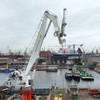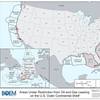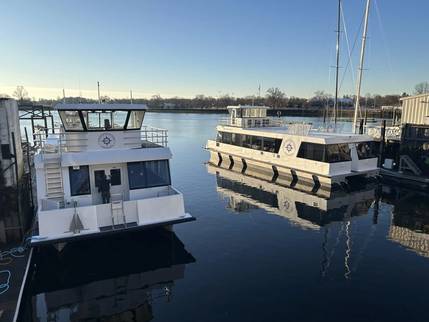Round the Clock Business Demands Seamless Comms
Network Innovations and its inland waterways connectivity solution eliminates “dead spot” coverage woes. And, not a moment too soon.
The bane of inland operators – or at least one of many – has always been the dearth of reliable and economical vessel-to-shore communications. Even in America’s heartland where cellular coverage is routinely billed as seamless, so-called ‘dead spots’ persist. Sometimes, this happens at the worst possible moment for an operator who has myriad far flung assets on dozens of remote inland waterways. For a long time, satellite service has not been deemed economically feasible for inland operators. Beyond that, unlike blue water deep sea operators, there was little need to download data or employ software solutions in every day operations. Until now.
Spotty cellular coverage – indeed using cellular coverage as a primary tool – became even more of a problem as the brown water industry caught up to its blue water cousins in terms of modern methods of vessel, operations and safety management. The issue is only likely to become more pronounced as subchapter M requirements continue to impact the more than 5,000 previously uninspected vessels that ply inland waters today. It turns out that software and better vessel-to-shore communications will play a much bigger role in the coming years. Hence, the traditional (read: good enough, but not quite ideal) cellular solution might just go the way of the inland operator with no safety management plan.
Actually, and according to satellite communications integrator Network Innovations and Dunlap Towing, there is a better way. For its part, Dunlap Towing, a west coast-based tug operator – has overcome the usual “dead spot” problem and the dropped calls associated with remote communications using Inmarsat’s Fleet One Service. And, satellite communications integrator Network Innovations was the conduit that made it happen.
Case Study
Dunlap Towing Company, a marine transportation services provider for almost a century, offers towing and assist services throughout the Puget Sound, along the Pacific Coast into Canada, to Alaska including remote ports above the Arctic Circle, and across the Pacific Ocean to Hawaii and beyond. But, for Dunlap, who operates a 12-Vessel Fleet, it has been the coastal routes around Dutch Harbor and the Pacific Coast that have traditionally been challenging with patchy service and limited access to communication networks. Most satellite and terrestrial services did not offer the always-available connectivity required to transmit important operating and safety reports or make critical inter-fleet voice calls. The team at Dunlap were frustrated and realized they were wasting time and money on a service that could not meet their needs in remote coastal waters.
With Dunlap’s operating routes extending to Hawaii, as well as the Pacific Northwest and Bering Sea, the company needed a service that could accommodate its coastal requirements and support its longer open water routes providing a reliable, guaranteed connection. Ultimately, Network Innovations assessed Dunlap’s requirements and presented the Inmarsat’s Fleet One Service with Cobham’s Fleet One hardware as the ideal solution.
One Solution, Economical Results
With Fleet One, regional vessel operators can stay connected without having to worry about cellular availability or network roaming charges. That’s because Fleet One gives vessel managers and owners the assurance they can stay connected at all times ensuring operational continuity and fleet communications. Nevertheless, price – especially for coastwise and inland operators – is always a perceived issue when it comes to satellite solutions. And, Dunlap Towing is no less thrifty than the next workboat operator.
Fleet One provides a diverse range of plans and options to fit a variety of needs. Dunlap selected the Pacific Northwest Regional Plan as a cost-effective option that would allow the tug fleets to talk vessel-to-vessel for up to 30-minutes for free plus the ability to have coverage in the open sea.
Matt George, Vice President Global Maritime Sales for Network Innovations, explained, “Because of our strong partner relationships in the North West Pacific region, my local dealer was able to connect Network Innovations to Dunlap allowing us to provide a perfect solution that not only supports their business today, but well into the future.” He added, “Fleet One and the Pacific Northwest Plan work together allowing companies like Dunlap to expand their businesses, routes, and services knowing their communication technologies are supported by strong, experienced partners. The support teams are great. They respond quickly via phone or email. It is nice to know that at any time, we can pick up the phone and call the tugs no matter where they are and the crews can do the same.”
Utilizing Fleet One, Dunlap has eliminated the patchy coverage on all of its operating routes from Hawaii to the Aleutian Islands. Now its vessels can reliably access full-color weather images, navigational charts and routing information, as well as sending/receiving reports, browsing the web, send/receive emails, text and talk close to shore and at sea. With Inmarsat’s free 505 Emergency Calling service included, Fleet One provides an additional level of safety for its crew.
Since installing Fleet One, Dunlap has switched to as pure satellite solution. And, where some might think that satellite service is too expensive, Dunlap has experienced exactly the opposite outcome. “Since we have started using Fleet One, our tugs are able to travel to remote areas without interruptions, our monthly bills have been cut in half, dropped calls and missing reports don’t happen anymore,” said Jack Sanford, Inside Operations Manager, Dunlap Towing Company. Ultimately, Dunlap made the switch to Fleet One in March of 2017 and has never looked back. That’s in part because Fleet One equipment is always activated and ready for use, while data capability is normally off until enabled. Voice is always active ready to be used.
Inland Economy
For tug operators – indeed any workboat stakeholder – space is always at a premium. And, big things can come in small packages. The Network Innovations solution for inland and coastal operators incorporates a compact antenna that easily installs on tugs and pushboats. For Dunlap, this solution was an ideal one, especially since their equipment travels to many remote places, as well as in close proximity to inland routes. That said; inland-only operators have long felt that the cost of satellite service could not be supported in their business plans. That might be about to change. For example, coastal services start at $28 per month, $0.49 per minute for voice, and $4-5 per MB for that all important data download in an increasingly tech heavy inland business climate.
Increasingly, today’s tug and barge operators employ software and data packages to run their safety and management systems. Syncing these systems between vessel and shore is important. The Fleet One service currently supports a download speed of up to 100kbps with later plans in the works to raise it to 150kbps.
Incorporated in 1988, Network Innovations (NI) is a satellite communications integrator, focused in the provision and support of systems which enable its customers to communicate anywhere on the planet. In this case, the advent of satellite communications for non-traditional users – such as inland and coastal operators – heralds a new and more affordable option that satisfies an increasingly hungry inland appetite for uninterrupted communication, faster and more robust data downloads, and, of course, that extra competitive advantage that can mean the difference between robust profits and those dreaded ‘dead spots’ that spell failure.















